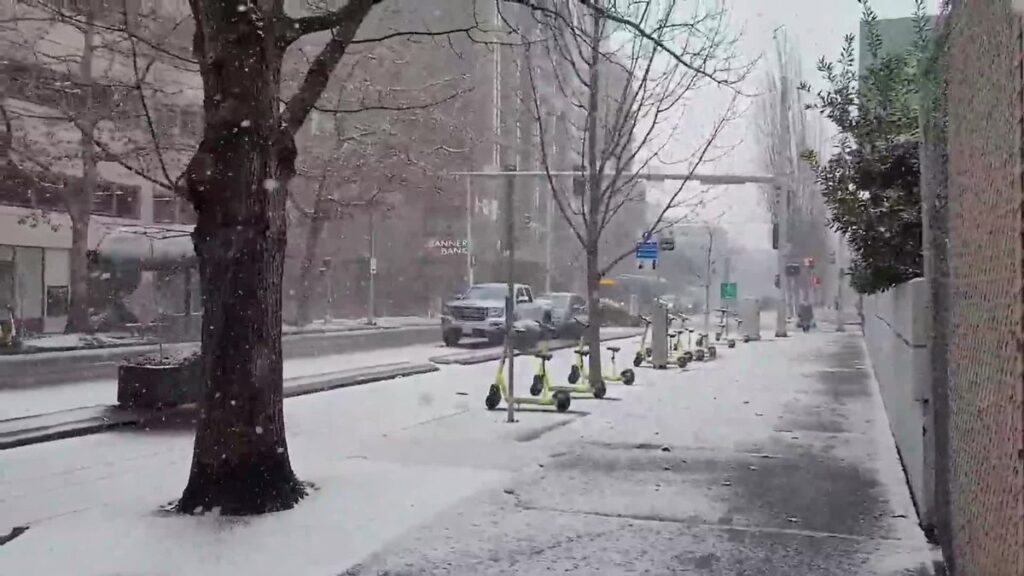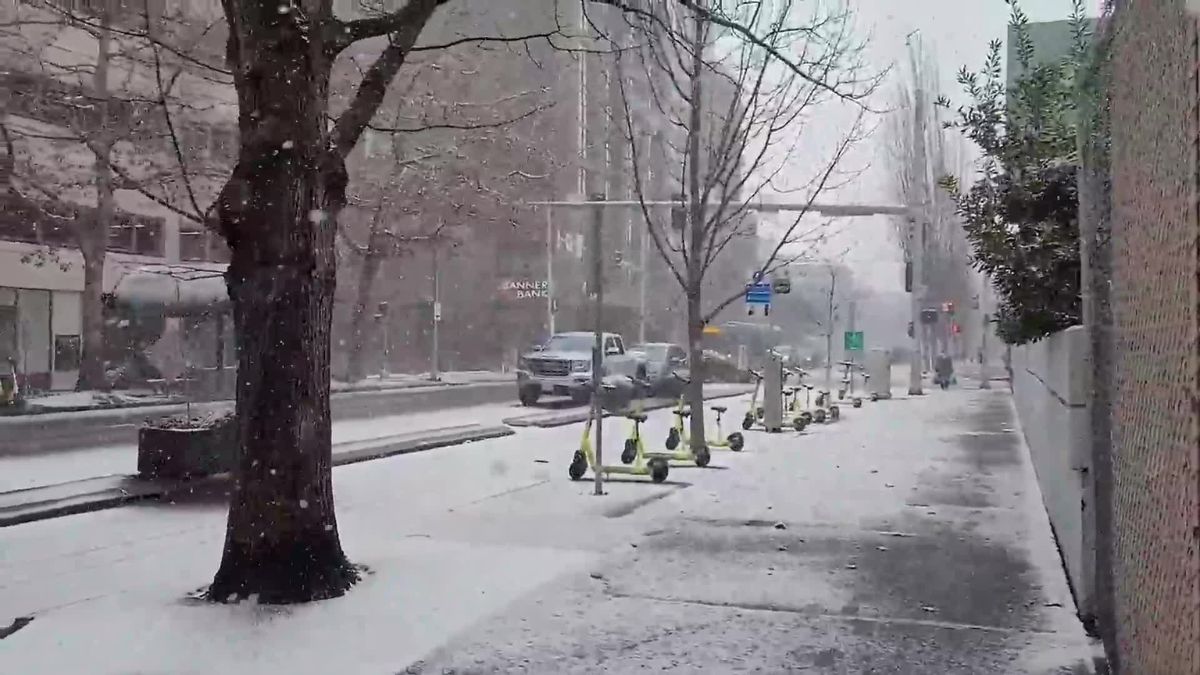Yes, it does snow in Seattle with moderate frequency. The city experiences moderate temperatures throughout the year, which include occasional snowfall. The average temperature of Seattle in winter ranges between the mid-30s to low 40s Fahrenheit.
The city experiences a relatively mild winter compared to many other regions in the United States and other parts of the world. However, it’s important to note that temperatures can vary throughout the winter months, and occasional colder spells or milder periods may occur.

Seattle’s proximity to the Pacific Ocean and the moderating effect of ocean currents help keep the temperatures relatively moderate during winter, contributing to the city’s mild climate overall.
Seattle, known for its lush green landscapes, vibrant cultural scene, and the iconic Space Needle, is a city nestled in the Pacific Northwest region of the United States. While the city experiences a mild and temperate climate for most of the year, the question that often arises is, “Does it snow in Seattle?”
In this article, we will explore the snowfall patterns in Seattle, how frequently it snows, and the impact of snow on the city’s residents and infrastructure.
Location Overview
Seattle is located in the Pacific Northwest of the United States, nestled between the Puget Sound and Lake Washington. It spans approximately 142.5 square miles and is the largest city in Washington State.
The city has a temperate maritime climate with mild winters and warm summers. Seattle’s location provides easy access to attractions like Mount Rainier National Park and Olympic National Park. It is a thriving metropolitan area known for its tech industry, arts scene, and coffee culture.
Geography and Climate of Seattle
It is essential to comprehend Seattle’s geography and overall climate. Seattle has a maritime climate characterized by mild winters, moderate temperatures, and abundant rainfall throughout the year.
The geographical significance of snowfall in Seattle is closely tied to the city’s unique location and topography. Several geographical factors contribute to the patterns and impact of snowfall in Seattle.
Seattle’s proximity to the Pacific Ocean influences its climate, resulting in milder winters than inland areas. This proximity helps moderate temperatures and reduces the likelihood of heavy snowfall.
Seattle is bordered by mountain ranges, creating a “rain shadow effect,” causing precipitation to be reduced before reaching the city. Consequently, Seattle receives less snowfall compared to areas on the western slopes of the mountains.
While Seattle has lower elevations, higher elevations in the surrounding areas receive more snowfall. Snowfall becomes more common as you move away from the city center and towards the mountainous regions or suburbs.
Historical Snowfall Record
Seattle’s historical snowfall record showcases the variability of snowfall in the city over the years. Here are some notable records:
The greatest one-day snowfall recorded in Seattle occurred on February 2, 1916, when a massive snowstorm brought 21.5 inches of snow to the city. This remains the highest single-day snowfall on record.
January 1950 holds the record for the snowiest month in Seattle’s history, with a total snow accumulation of 57.2 inches.
Seattle experienced an unusually long period of consecutive days with snowfall from December 11 to December 23, 2008. The city saw snow for 11 consecutive days during this period, setting a record for the most extended stretch of continuous snowfall.
It is important to note that these records represent extreme or exceptional events and do not reflect the typical snowfall patterns in Seattle. On average, Seattle receives around 5.9 inches of snowfall per year.
Winter Season & Snowfall Pattern
On average, Seattle receives around 5.9 inches of snowfall per year. However, it is important to note that this is an average value, and snowfall amounts can vary significantly yearly. Some years may see no snow, while others may experience occasional snowstorms that bring a few inches of snow.
While Seattle experiences a fair amount of rainfall, snowfall is relatively rare. The city’s proximity to the Pacific Ocean and the presence of the Olympic and Cascade mountain ranges greatly influence its snowfall patterns.
Effects of Snowfall in Seattle
Snowfall in Seattle is relatively infrequent compared to other cities located in colder regions. The frequency of snowfall tends to increase as you move away from the city center towards the higher elevations and areas closer to the mountains.
Given the rarity of snow in Seattle, even a small amount of snowfall can significantly impact the city. As Seattle is not accustomed to heavy snow, it can create challenges for transportation, infrastructure, and daily life.
Roads and highways may become icy and treacherous, causing disruptions in traffic flow. Public transportation systems may experience delays or service suspensions. Additionally, snow-covered trees and power lines can lead to power outages in some areas.
Locations to Enjoy Snow
Seattle and its surrounding areas offer several locations where you can enjoy the beauty of snow. Here are some popular spots:
- Snoqualmie Pass
Located just east of Seattle in the Cascade Mountains, Snoqualmie Pass is a winter wonderland perfect for snow enthusiasts. The pass features multiple ski resorts, including The Summit at Snoqualmie, offering skiing, snowboarding, snowshoeing, and tubing opportunities.
- Mount Rainier National Park
A short drive from Seattle, Mount Rainier National Park provides breathtaking winter scenery. With its towering snow-capped peak, the park offers opportunities for snowshoeing, cross-country skiing, and winter hiking along designated trails.
- Crystal Mountain
Located southeast of Seattle near Mount Rainier, Crystal Mountain is a popular ski resort offering a range of winter activities. Skiing, snowboarding, snowshoeing, and snowmobiling can be enjoyed in this picturesque setting.
- Leavenworth
Approximately two hours east of Seattle, the Bavarian-themed town of Leavenworth transforms into a magical winter destination. Visitors can enjoy snow-covered streets, festive lights, and a variety of winter activities, including sledding, ice skating, and snowmobiling.
- Paradise, Mount Rainier
Paradise is a popular winter destination within Mount Rainier National Park. With its stunning landscapes and abundant snowfall, visitors can engage in snowshoeing, cross-country skiing, and winter photography while surrounded by the park’s natural beauty.
- Stevens Pass
Situated in the Cascade Mountains, Stevens Pass is a renowned ski resort offering diverse terrain for skiing and snowboarding. The area also features snowshoe trails and winter events, making it a great spot for snow lovers.
- Green Lake Park
Located within Seattle city limits, Green Lake Park offers a scenic setting for winter activities. When the lake freezes, visitors can enjoy ice skating or play winter sports on the frozen surface, creating a unique winter experience in the city’s heart.
These locations provide opportunities to embrace the beauty of snow in and around Seattle. Whether you prefer skiing, snowboarding, snowshoeing, or simply enjoying the winter scenery, these spots offer memorable winter adventures.
Conclusion
While Seattle is not known for its heavy snowfall, the city experiences occasional snowstorms during the winter months. Nevertheless, when snow does blanket the city, it brings both challenges and a sense of wonder to the residents.
Whether Seattleites are navigating the snowy streets or enjoying outdoor winter activities, the infrequent snowfall adds a touch of magic to this vibrant Pacific Northwest city.
